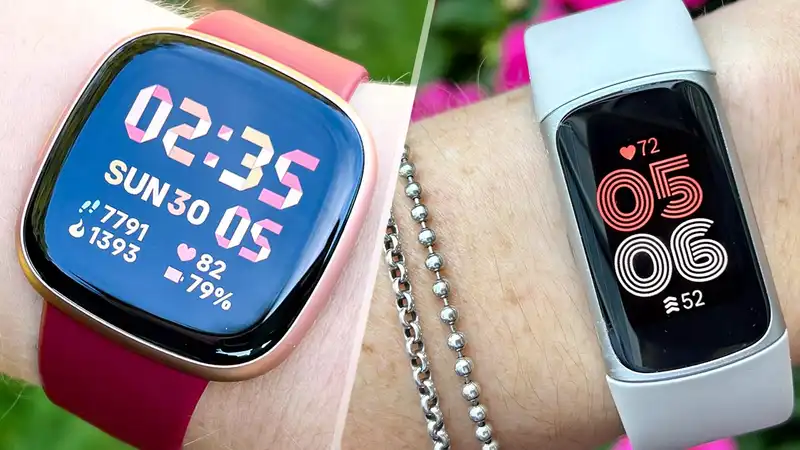With a budget of $200, you can get many excellent fitness trackers in 2024, including the Fitbit Charge 6 and Fitbit Versa 4 In fact, given the price difference of only $40, it may be hard to choose between the two But don't worry We can help you sort it out
The most obvious visual difference is that the Versa has a larger case and screen But under the hood, there are other noticeable differences: the Charge 6 offers a broader suite of health and wellness technologies, including an ECG sensor to monitor heart rhythms and an EDA sensor to track stress levels
However, both devices monitor basics such as heart rate, steps, distance, calories burned, and sleep quality Both models also include GPS to track more than 40 activities, from skiing to swimming [The Charge 6 is Fitbit's premium banded fitness tracker The Versa 4, on the other hand, is Fitbit's mid-range smartwatch for fitness enthusiasts and sits next to the more expensive Fitbit Sense 2 in the 2024 lineup
So which is right for you, the Fitbit Charge 6 or the Versa 4?
Both the Fitbit Charge 6 and Fitbit Versa 4 are available directly from Fitbit or from third-party retailers like Amazon; the MSRP for the Fitbit Charge 6 is $159, but it is often available on sale for $129 The Fitbit Versa 4 sells for $199
Each model comes with six months of free Fitbit Premium, which unlocks useful features such as personalized training sessions, deeper sleep analysis, and daily readiness scores
The pricier Versa 4 has a larger screen footprint than the Charge 6, which makes sense given its smartwatch pedigree However, both screens are bright, crisp, responsive, and saturated AMOLED
At 05 ounces, the Charge 6 is lighter than the Versa's 08 ounces Neither is particularly heavy and comfortable to wear However, those with smaller wrists may find the Charge 6 less cumbersome, especially at night Each comes with a soft silicone strap that can be easily interchanged with a variety of straps
The aluminum case gives both devices a premium look Each side has one button similar to Apple's action button Battery life is respectable for both, with seven days for the Charge and six days for the Versa
The Charge 6 comes in a black case with a black strap, a silver case with a porcelain strap, and a rose gold case with a coral strap; the Versa 4 comes in a black case with a black strap and a platinum case with a blue strap, pink strap on the rose gold case, and a red strap on the rose gold case
For top-class fitness and wellness features, the Fitbit Charge 6 is the best choice, with two sensors not found on the Versa 4, ECG and EDA [The ECG sensor is used to monitor heart rhythms and allows users to monitor for signs of atrial fibrillation (AFib)
The Charge 6's EDA sensor monitors changes in the user's skin charge (ie, it is essentially a sweat sensor) This data is combined with heart rate data to determine overall stress levels
The Versa 4 can also monitor stress and provide a daily stress management score, but it does so with less data than the Charge 6 Nevertheless, both devices monitor sleep quality, menstrual health, respiration, and heart rate; unlike the Apple Watch 9 and Ultra 2, these Fitbits can monitor blood oxygen saturation with the Sp02 sensor
Both devices have built-in GPS, allowing users to leave their phones at home without sacrificing accurate distance tracking for running or cycling Similarly, users can track an equally long list of physical activities with either device The Versa 4, however, has an altimeter to track elevation gain; the Charge, unfortunately, does not
Both Fitbits are water resistant to 50 meters, so they can be worn safely while swimming
The Versa 4 has several smartwatch features that the Charge 6 does not, including voice support for Amazon's Alexa digital assistant and Bluetooth calling via paired devices
Both Fitbit models receive calls, texts, and app notifications and support several useful apps like Google Wallet and Google Maps Unfortunately, neither device offers storage or support for listening to music offline; the Charge 6 can work with YouTube Music It just needs to be paired with another device
Other than the above, smart features are scarce on both Frustratingly, neither supports the Google Play Store or Google Assistant, even though Alphabet Inc owns Fitbit [For many, the Fitbit Charge 6 is a better choice than the Fitbit Versa 4 Both devices are capable fitness trackers with beautiful screens, solid battery life, and a handful of smart features However, the Charge 6 has the edge with its upgraded health and stress monitoring technology For this reason, we rate the Charge 6 as one of the best fitness trackers available today
If you want a fitness wearable with even smarter features than Fitbit, consider the Apple Watch SE (2022) or the Samsung Galaxy Watch 5 Both are on our list of best smartwatches and have a full-fledged smartwatch user interface, including access to thousands of apps, in addition to basic fitness tracking features such as step counting, GPS, and heart rate monitoring
Those looking for a fitness tracker with even more high-tech and wellness insights than the Fitbit Charge 6 may want to consider the Garmin Forerunner 265 It is more expensive, but offers much more advanced metrics than its competitors










Comments